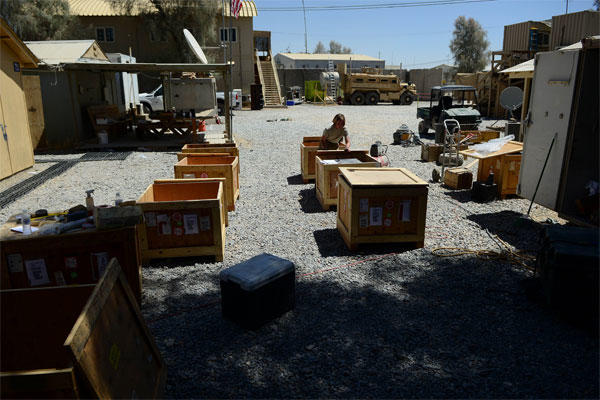KANDAHAR AIRFIELD, Afghanistan -- There have been 20 rotations of more than 600 explosive ordnance disposal technicians who have left their mark in the history of Operation Enduring Freedom since the 2004 inception of the 466th EOD Operating Location Bravo Flight here.
With more than 10,000 missions completed, Aug. 19 marked the unit's final mission. Although they completed the last Air Force EOD mission in Afghanistan, the unit still has a retrograde mission to support in order to officially close. As their last chapter closes in September 2014, the flight's final rotation is ensuring all assets are returned and their history remembered upon their departure.
"Our impact to Operation Enduring Freedom has been huge," said Capt. Justin Shultz, the 466th EOD Operating Location Bravo Flight executive officer, deployed from Luke Air Force Base, Arizona. "Because of our abilities and technical expertise, I feel like we have become one of the front line EOD units in Afghanistan during our time here. The main weapon of choice by insurgents is improvised explosive devices, therefore we had a huge impact on operations, without us it would have been harder for infantry units and transportation to get out and do their jobs."
Air Force EOD units in southern Afghanistan were originally part of Joint Task Force Paladin in 2001; three years later the 466th EOD Operating Location Bravo flight was created. During their tenure here, the unit supported Kandahar Airfield force protection and provided response for explosive hazard threats. The flight also had EOD technicians operating from six different forward bases in the surrounding area in the past years.
"Our unit responded to any explosive hazard on and off base, such as unexploded ordnances, improvised explosive devices and post blasts," said Shultz, a native of Ashland, Missouri. "After a vehicle is hit, our job is to go out and determine why it happened. And, if a new tactic was used, then we try to develop a counter measure to advise battle space owners on what they can to do mitigate that risk."
During the years, the unit created many memorials honoring those who served in the unit and the eight who died. They hope to preserve the unit's legacy by keeping and shipping the memorials to the Air Force Civil Engineer Center at Joint Base San Antonio-Lackland, Texas.
"One thing we made sure before we left was to clean and send back all the plaques and memorials that were made for our fallen EOD brothers," Shultz said. "This was the member's way of coping so we want the plaques to be dispersed to the other flights, family and friends. We don't want to leave anything behind because when we leave here no one is going to know what this place was, and what it meant.
"The support personnel with EOD are instrumental in getting all the retrograde done in the proper time frame," he continued. "I have seen here how the retrograde process can be done right. We have been fortunate to have a great support staff that takes care of us while we take care of the mission. "
The retrograde process includes a request of equipment disposition to either dispose of or return EOD assets to their respective home station.
"We started the process in April, and we finally hit end of mission Aug. 19," said Tech. Sgt. Stacy Trosine, the 466th EOD Operating Location Bravo Flight logistics management NCO-in-charge, deployed from Fairchild Air Force Base, Washington. "Now we are finishing turning things in through customs and getting it back to the states."
According to Trosine, a native of Colbert, Washington, the unit has about $30 million worth of combined Army and Air Force assets that need to be returned. Some will return to Army accounts and some shipped to Hill Air Force Base, Utah, the EOD retrograde facility.
"Here we have both Air Force and Army assets, I had to learn how the Army disposition process works," Trosine said. "I have also never closed down a unit, but it has been great to see how everything goes."
According to Trosine, with 14 years' worth of accumulated assets, it’s not only mission equipment but also communication gear, office supplies, and furniture that needs to be retrograded. Before any of the equipment is returned, it must be cleaned, inventoried and properly packed to be cleared through customs.
Taking accountability of items that have been part of history is an experience Trosine said he finds exciting.
"To be part of history is great," Trosine said. "When I am inventorying the items, the EOD techs explain to me what some of the equipment is used for, and it is amazing to see and learn how all of these tools have helped save the lives of the techs out there."
According to Shultz, being part of the last Air Force EOD unit in Afghanistan has been bittersweet.
"It's bittersweet because we didn't get to do as much of the fast paced operations as our previous EOD brothers, but at the same time that's good because it means we did our job correctly by making it safer for everyone out here," he said.





























